SUMMARY CMI
Dupixent®
Consumer Medicine Information (CMI) summary
The full CMI on the next page has more details. If you are worried about using this medicine, speak to your doctor or pharmacist.
▼ This medicine is new or being used differently. Please report side effects. See the full CMI for further details.
1. Why am I using Dupixent?
Dupixent contains the active ingredient Dupilumab. It is used to treat severe atopic dermatitis in patients between 6 months to 11 years of age, moderate to severe atopic dermatitis in patients aged 12 years and older, prurigo nodularis in adults, moderate to severe asthma in patients aged 6 years and older, adults with chronic rhinosinusitis with nasal polyposis, and adults with uncontrolled chronic obstructive pulmonary disease. For more information, see Section 1. Why am I using Dupixent? in the full CMI.
2. What should I know before I use Dupixent?
Do not use if you have ever had an allergic reaction to Dupixent or any of the ingredients listed at the end of the CMI.
Talk to your doctor if you have any other medical conditions, take any other medicines, or are pregnant or plan to become pregnant or are breastfeeding. For more information, see Section 2. What should I know before I use Dupixent? in the full CMI.
3. What if I am taking other medicines?
Some medicines may interfere with Dupixent and affect how it works. A list of these medicines is in Section 3. What if I am taking other medicines? in the full CMI.
4. How do I use Dupixent?
- Dupixent should be injected under the skin every other week or every 4 weeks. Your doctor will tell you how much you need to use. Change your injection site regularly. Carefully follow the instructions on how to inject under the skin.
More instructions can be found in Section 4. How do I use Dupixent? in the full CMI.
5. What should I know while using Dupixent?
| Things you should do |
|
| Things you should not do |
|
| Looking after your medicine |
|
For more information, see Section 5. What should I know while using Dupixent? in the full CMI.
6. Are there any side effects?
Serious side effects may include an allergic reaction. Common side effects may include eye dryness, eye infection, eye and eyelid inflammation. For more information, including what to do if you have any side effects, see Section 6. Are there any side effects? in the full CMI.
▼ This medicine is subject to additional monitoring. This will allow quick identification of new safety information. You can help by reporting any side effects you may get. You can report side effects to your doctor, or directly at www.tga.gov.au/reporting-problems.
FULL CMI
Dupixent®
Active ingredient(s): dupilumab (du-pil-u-mab)
Consumer Medicine Information (CMI)
This leaflet provides important information about using Dupixent. You should also speak to your doctor or pharmacist if you would like further information or if you have any concerns or questions about using Dupixent.
Where to find information in this leaflet:
1. Why am I using Dupixent?
2. What should I know before I use Dupixent?
3. What if I am taking other medicines?
4. How do I use Dupixent?
5. What should I know while using Dupixent?
6. Are there any side effects?
7. Product details
1. Why am I using Dupixent?
Dupixent contains the active ingredient dupilumab. Dupixent belongs to a class of medicines called monoclonal antibodies.
Dupixent is used to treat the following conditions:
1) moderate to severe atopic dermatitis (also known as atopic eczema), in patients aged 12 years and older. Dupixent is also used to treat severe atopic dermatitis in patients between 6 months to 11 years old.
In atopic dermatitis, Dupixent may be used with or without prescribed atopic dermatitis medicines that you apply to the skin.
2) prurigo nodularis in adult patients whose disease is not controlled with their current medication.
3) maintenance treatment of moderate-to-severe asthma in patients 6 years and older whose asthma is not controlled with their current asthma medicines.
In asthma, Dupixent should be used in addition to your existing asthma medicines. Dupixent may also help reduce the amount of oral corticosteroids you need while preventing severe asthma attacks and improving your breathing.
4) maintenance treatment of chronic rhinosinusitis in adults with nasal polyposis (CRSwNP) in adults whose disease is not controlled with their current CRSwNP medicines.
5) maintenance treatment of chronic obstructive pulmonary disease (COPD) in adults not well enough controlled with your current inhaler medication. Adding Dupixent helps prevent moderate or severe COPD attacks (exacerbations) and can improve your breathing. Dupixent may also help to improve overall symptoms of COPD. Your doctor will assess if Dupixent is appropriate for your condition.
2. What should I know before I use Dupixent?
Warnings
Do not use Dupixent if:
- You are allergic to dupilumab, or any of the ingredients listed at the end of this leaflet.
- Always check the ingredients to make sure you can use this medicine.
- The product appears cloudy, discoloured or contains particles, or if the syringe, pen and/or needle cap appear damaged.
Check with your doctor if you:
- Have a parasitic (helminth) infection
- Have any other medical conditions, including any new or worsening eye problems, including eye pain or changes in vision
- Take any medicines for any other condition including oral, or using topical, or inhaled corticosteroid medicines
- Have recently received or are scheduled to receive a vaccine
During treatment, you may be at risk of developing certain side effects. It is important you understand these risks and how to monitor for them. See additional information under Section 6. Are there any side effects?
Pregnancy and breastfeeding
Check with your doctor if you are pregnant or intend to become pregnant.
Talk to your doctor if you are breastfeeding or intend to breastfeed.
Atopic Dermatitis
- Do not use Dupixent in patients under 6 months old.
The safety and benefits of Dupixent are not yet known in this patient group.
Prurigo Nodularis
- Do not use Dupixent in patients under 18 years old.
The safety and benefits of Dupixent are not yet known in this patient group.
Asthma
- Do not use Dupixent in patients under 6 years old.
The safety and benefits of Dupixent are not yet known in this patient group. - Dupixent is not a rescue medicine and should not be used to treat a sudden asthma attack
Chronic Rhinosinusitis with Nasal Polyposis (CRSwNP)
- Do not use Dupixent in patients under 18 years old.
The safety and benefits of Dupixent are not yet known in this patient group.
Chronic Obstructive Pulmonary Disease (COPD)
- Do not use Dupixent in patients under 18 years old.
The safety and benefits of Dupixent are not yet known in this patient group. COPD does not normally occur in children. - Dupixent is not a rescue medicine and should not be used to treat a sudden COPD attack (exacerbation).
3. What if I am taking other medicines?
Tell your doctor or pharmacist if you are taking any other medicines, including any medicines, vitamins or supplements that you buy without a prescription from your pharmacy, supermarket or health food shop.
Do not stop taking your corticosteroid medicines unless instructed by your doctor.
This may cause other symptoms that were controlled by the corticosteroid medicine to come back.
You should not receive certain type of vaccines while taking Dupixent. Tell your doctor if you have recently received a vaccine or planned to receive a vaccine.
Check with your doctor or pharmacist if you are not sure about what medicines, vitamins or supplements you are taking and if these affect Dupixent.
4. How do I use Dupixent?
Follow all directions given to you by your doctor and pharmacist carefully.
Carefully read the "Dupixent Instructions for Use" provided in the carton. If you do not understand the instructions on the label or in this leaflet, ask your doctor or pharmacist for help.
How much to use
- Use the dose that your doctor prescribes for you
- Dupixent is given as an injection under the skin (subcutaneously) every other week or every 4 weeks.
How long to use Dupixent
- Continue using Dupixent for as long as your doctor recommends.
- Make sure you keep enough Dupixent to last when you go on holidays.
How to use Dupixent
Always check the syringe/pen label before each injection to make sure you are using the right medicine.
Dupixent is a clear and colourless to pale yellow solution that should not be shaken before use.
Do not use Dupixent if it is not clear to pale yellow or if it contains particles.
To avoid discomfort, Dupixent should be removed from the refrigerator before your injection so that it reaches room temperature.
- Remove Dupixent 300mg syringes/pens from the refrigerator at least 45 minutes before injection.
- Remove Dupixent 200mg syringes/pens from the refrigerator at least 30 minutes before injection.
In adult patients, the injection can be self-administered or given by another person, after proper training in injection technique.
In adolescents 12 years of age and older, it is recommended that Dupixent be given by or under the supervision of an adult.
Dupixent should be given by a caregiver in children 6 months to 11 years of age. The pre-filled syringe presentation should be used for children in this age group.
Dupixent is injected under the skin (subcutaneous injection). You can inject into the thigh or abdomen, except for the 2 inches (5 cm) around the navel, using a single-dose pre-filled syringe or pen. If somebody else administers the injection, the upper arm can also be used. Use a different injection site each injection so that the same site is not used.
Do not inject in an area where the skin that is tender, damaged, sunburnt or has bruises or scars.
Do not inject Dupixent with other injectable medicines, at the same injection site.
If you forget to use Dupixent
If your dose schedule is every other week and you miss a dose of Dupixent, give the injection within 7 days from the missed dose, then continue with the original schedule.
If the missed dose is not given within 7 days, wait until the next scheduled dose to give your Dupixent injection.
In case you are not sure when to inject Dupixent, call your doctor or pharmacist.
If your dose schedule is every 4 weeks and you miss a dose of Dupixent, give the Dupixent injection within 7 days from the missed dose, then continue with your original schedule. If the missed dose is not given within 7 days, start a new every 4 week dose schedule from the time you take your Dupixent injection.
It is important to use Dupixent as prescribed by your doctor.
If you use too much Dupixent
If you think that you have used too much Dupixent, you may need urgent medical attention.
You should immediately:
- phone the Poisons Information Centre
(by calling 13 11 26), or - contact your doctor, or
- go to the Emergency Department at your nearest hospital.
You should do this even if there are no signs of discomfort or poisoning.
5. What should I know while using Dupixent?
Things you should do
Always follow your doctor's instructions carefully.
If you have asthma and are taking asthma medicines, do not change or stop your asthma medicine without talking to your doctor.
It is important to keep using Dupixent even if you feel well.
Continuous use of Dupixent helps to control your condition.
Call your doctor straight away if you:
- Experience any of the following symptoms:
- a flu-like illness
- pins and needles or numbness of arms or legs
- worsening of lung symptoms including breathing problems,
- and/or rash.
Remind any doctor, dentist or pharmacist you visit that you are using Dupixent.
Things you should not do
- Do not expose the syringe or pen to heat or direct sunlight.
- Do not use a syringe or pen if it is damaged or you are not sure that it is working properly. Use a new syringe or pen.
- Do not use Dupixent if you think it has been frozen or exposed to excessive heat (temperatures above 25°C).
- Do not give Dupixent to anyone else, even if they have the same condition as you.
- Do not stop taking your corticosteroid medicines unless instructed by your doctor.
- This may cause other symptoms that were controlled by the corticosteroid medicine to come back
- Do not stop taking your medicine without checking with your doctor.
Driving or using machines
Dupixent is unlikely to influence your ability to drive and use machines.
Looking after your medicine
Before use, keep Dupixent syringes and pens in a refrigerator where the temperature is between 2-8°C. If necessary, pre-filled syringes and pens can be kept at room temperature up to 25°C for a maximum of 14 days.
Keep the syringes and pens in the original carton to protect from light.
Do not allow it to freeze. Discard if frozen.
Do not expose to heat. Do not shake.
Follow the instructions in the carton on how to take care of your medicine properly.
Keep it where young children cannot reach it.
When and how to discard your medicine
After injecting Dupixent, immediately throw away the used pre-filled syringe in a sharps container as instructed by your doctor or pharmacist.
After removal from the refrigerator, Dupixent must be used within 14 days or discarded.
Getting rid of any unwanted medicine
If you no longer need to use this medicine or it is out of date, take it to any pharmacy for safe disposal.
Do not use this medicine after the expiry date.
6. Are there any side effects?
All medicines can have side effects. If you do experience any side effects, most of them are minor and temporary. However, some side effects may need medical attention.
See the information below and, if you need to, ask your doctor or pharmacist if you have any further questions about side effects.
Less serious side effects
| Less serious side effects | What to do |
Injection site-related:
| Speak to your doctor if you have any of these less serious side effects and they worry you. |
Serious side effects
| Serious side effects | What to do |
Allergic reaction-related:
| Call your doctor straight away, or go straight to the Emergency Department at your nearest hospital if you notice any of these serious side effects. |
Tell your doctor or pharmacist if you notice anything else that may be making you feel unwell.
Other side effects not listed here may occur in some people.
Reporting side effects
After you have received medical advice for any side effects you experience, you can report side effects to the Therapeutic Goods Administration online at www.tga.gov.au/reporting-problems. By reporting side effects, you can help provide more information on the safety of this medicine.
Always make sure you speak to your doctor or pharmacist before you decide to stop taking any of your medicines.
7. Product details
This medicine is only available with a doctor's prescription.
What Dupixent contains
| Active ingredient (main ingredient) | Dupilumab |
| Other ingredients (inactive ingredients) |
|
What Dupixent looks like
Dupixent is a clear and colourless to pale yellow, preservative-free liquid solution available in a pre-filled syringe with needle shield or a pre-filled pen.
The needle shield reduces the risk of accidental needle stick injuries.
Dupixent is available in three different strengths:
- 300 mg in 2 mL solution
- 200 mg in 1.14 mL solution
Dupixent 300 mg (150 mg/mL) pre-filled syringe with needle shield (AUST R 283127)
Dupixent 300 mg (150 mg/mL) pre-filled pen (AUST R 382594)
Dupixent 200 mg (175 mg/mL) pre-filled syringe with needle shield (AUST R 302463)
Dupixent 200 mg (175 mg/mL) pre-filled pen (AUST R 382593)
Who distributes Dupixent
Dupixent is supplied in Australia by:
sanofi-aventis australia pty ltd
12-24 Talavera Road
Macquarie Park NSW 2113
Freecall No: 1800 818 806
E-mail: [email protected]
This leaflet was prepared in February 2025
dupi-ccdsv30-cmiv18-25feb25
Published by MIMS May 2025


 The Dupixent pre-filled pen is for use in adult and paediatric patients aged 2 years and older.
The Dupixent pre-filled pen is for use in adult and paediatric patients aged 2 years and older. For children (6-11 years old) with asthma and co-morbid severe atopic dermatitis, the recommended dose should be followed in Table 1.
For children (6-11 years old) with asthma and co-morbid severe atopic dermatitis, the recommended dose should be followed in Table 1. Table 5 summarises the adverse reactions that occurred in ≥ 1% of patients treated with Dupixent during the first 16-weeks of treatment in placebo-controlled trials.
Table 5 summarises the adverse reactions that occurred in ≥ 1% of patients treated with Dupixent during the first 16-weeks of treatment in placebo-controlled trials. The safety profile of Dupixent + TCS through week 52 is consistent with the safety profile observed at week 16.
The safety profile of Dupixent + TCS through week 52 is consistent with the safety profile observed at week 16. In PRIME and PRIME2 PN studies, the proportion of patients who discontinued treatment due to adverse events was 0% of the dupilumab 300 mg Q2W group and 2.5% of the placebo group.
In PRIME and PRIME2 PN studies, the proportion of patients who discontinued treatment due to adverse events was 0% of the dupilumab 300 mg Q2W group and 2.5% of the placebo group. See Table 8.
See Table 8. The long-term safety of Dupixent was assessed in an open-label extension study in 2282 patients 12 years and older with moderate-to-severe asthma (TRAVERSE). In this study, patients were followed for up to 96 weeks, resulting in 3169 patient-years cumulative exposure to Dupixent. The safety profile of Dupixent in TRAVERSE was consistent with the safety profile observed in pivotal asthma studies for up to 52 weeks of treatment. No additional adverse reactions were identified.
The long-term safety of Dupixent was assessed in an open-label extension study in 2282 patients 12 years and older with moderate-to-severe asthma (TRAVERSE). In this study, patients were followed for up to 96 weeks, resulting in 3169 patient-years cumulative exposure to Dupixent. The safety profile of Dupixent in TRAVERSE was consistent with the safety profile observed in pivotal asthma studies for up to 52 weeks of treatment. No additional adverse reactions were identified. See Table 10.
See Table 10. The safety profile of Dupixent through Week 52 was generally consistent with the safety profile observed at Week 24.
The safety profile of Dupixent through Week 52 was generally consistent with the safety profile observed at Week 24.


 Treatment effects in subgroups (weight, age, gender, race, and background treatment, including immunosuppressants) in Study 1334 and Study 1416 were in general consistent with the results in the overall study population.
Treatment effects in subgroups (weight, age, gender, race, and background treatment, including immunosuppressants) in Study 1334 and Study 1416 were in general consistent with the results in the overall study population.

 Treatment effects in evaluable subgroups (weight, age, gender, race, and background treatment, including immunosuppressants) in Study 1224 were in general consistent with the results in the overall study population.
Treatment effects in evaluable subgroups (weight, age, gender, race, and background treatment, including immunosuppressants) in Study 1224 were in general consistent with the results in the overall study population. In SOLO CONTINUE, a trend for increased treatment-emergent ADA positivity with increased dosing intervals was observed. Treatment-emergent ADA: QW: 1.2%; Q2W: 4.3%; Q4W: 6.0%; Q8W: 11.7%. ADA responses lasting more than 12 weeks: QW: 0.0%; Q2W: 1.4%; Q4W: 0.0%; Q8W: 2.6%.
In SOLO CONTINUE, a trend for increased treatment-emergent ADA positivity with increased dosing intervals was observed. Treatment-emergent ADA: QW: 1.2%; Q2W: 4.3%; Q4W: 6.0%; Q8W: 11.7%. ADA responses lasting more than 12 weeks: QW: 0.0%; Q2W: 1.4%; Q4W: 0.0%; Q8W: 2.6%. A larger percentage of patients randomised to placebo needed rescue treatment (topical corticosteroids, systemic corticosteroids, or systemic non-steroidal immunosuppressants) as compared to the Dupixent group (58.8% and 20.7%, respectively).
A larger percentage of patients randomised to placebo needed rescue treatment (topical corticosteroids, systemic corticosteroids, or systemic non-steroidal immunosuppressants) as compared to the Dupixent group (58.8% and 20.7%, respectively).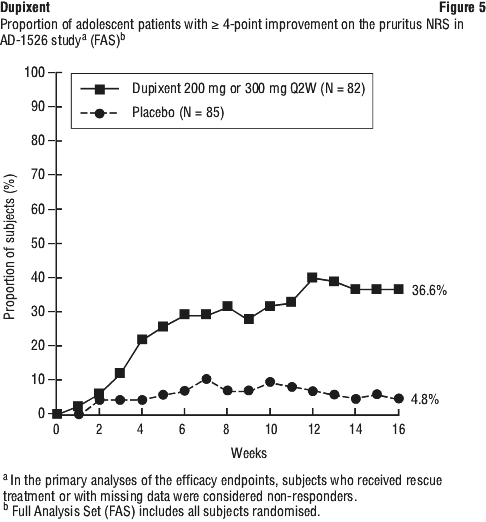 The long-term efficacy of Dupixent in adolescent patients with moderate-to-severe AD who had participated in previous clinical trials of Dupixent was assessed in open-label extension study (AD-1434). Efficacy data from this study suggests that clinical benefit provided at week 16 was sustained through week 52.
The long-term efficacy of Dupixent in adolescent patients with moderate-to-severe AD who had participated in previous clinical trials of Dupixent was assessed in open-label extension study (AD-1434). Efficacy data from this study suggests that clinical benefit provided at week 16 was sustained through week 52. A greater proportion of patients randomised to Dupixent + TCS achieved an improvement in the peak pruritus NRS compared to placebo + TCS (defined as ≥ 4-point improvement at week 4). See Figure 6.
A greater proportion of patients randomised to Dupixent + TCS achieved an improvement in the peak pruritus NRS compared to placebo + TCS (defined as ≥ 4-point improvement at week 4). See Figure 6. The Dupixent groups significantly improved patient-reported symptoms, the impact of AD on sleep and health-related quality of life as measured by POEM, SCORAD, and CDLQI scores at 16 weeks compared to placebo.
The Dupixent groups significantly improved patient-reported symptoms, the impact of AD on sleep and health-related quality of life as measured by POEM, SCORAD, and CDLQI scores at 16 weeks compared to placebo. A significantly greater proportion of patients randomised to dupilumab + TCS achieved a rapid improvement in the Worst Scratch/Itch NRS compared to placebo + TCS (defined as ≥ 4-point improvement as early as week 3, nominal p < 0.005) and the proportion of patients responding on the Worst Scratch/Itch NRS continued to increase through the treatment period (see Figure 7).
A significantly greater proportion of patients randomised to dupilumab + TCS achieved a rapid improvement in the Worst Scratch/Itch NRS compared to placebo + TCS (defined as ≥ 4-point improvement as early as week 3, nominal p < 0.005) and the proportion of patients responding on the Worst Scratch/Itch NRS continued to increase through the treatment period (see Figure 7). In this study, Dupixent significantly improved health-related quality of life as measured by the CDLQI (in 85 patients 4 to 5 years old) and IDQOL (in 77 patients 6 months to 3 years old). In the ITT population, greater LS mean changes in CDLQI and IDQOL scores from baseline to week 16 were observed in the dupilumab + TCS (-10.0 and -10.9) group compared to the placebo + TCS group (-2.5 and -2.0), respectively (p < 0.0001). Similar improvements in both CDLQI and IDQOL were observed in the severe AD population.
In this study, Dupixent significantly improved health-related quality of life as measured by the CDLQI (in 85 patients 4 to 5 years old) and IDQOL (in 77 patients 6 months to 3 years old). In the ITT population, greater LS mean changes in CDLQI and IDQOL scores from baseline to week 16 were observed in the dupilumab + TCS (-10.0 and -10.9) group compared to the placebo + TCS group (-2.5 and -2.0), respectively (p < 0.0001). Similar improvements in both CDLQI and IDQOL were observed in the severe AD population. The onset of action in change from baseline in WI-NRS, defined as the first timepoint at which difference from placebo was and remained significant (nominal p < 0.05) in the weekly average of daily WI-NRS, was observed as early as Week 3 in PRIME (Figure 8) and Week 4 in PRIME 2 (Figure 9).
The onset of action in change from baseline in WI-NRS, defined as the first timepoint at which difference from placebo was and remained significant (nominal p < 0.05) in the weekly average of daily WI-NRS, was observed as early as Week 3 in PRIME (Figure 8) and Week 4 in PRIME 2 (Figure 9).
 A greater proportion of patients experienced WI-NRS improvements of ≥ 4 points from baseline by Weeks 4 and 11 in the dupilumab group as compared to the placebo group in PRIME (Figure 10, nominal p < 0.007) and PRIME2 (Figure 11, nominal p < 0.013) respectively and this difference remained significant throughout the treatment period.
A greater proportion of patients experienced WI-NRS improvements of ≥ 4 points from baseline by Weeks 4 and 11 in the dupilumab group as compared to the placebo group in PRIME (Figure 10, nominal p < 0.007) and PRIME2 (Figure 11, nominal p < 0.013) respectively and this difference remained significant throughout the treatment period.
 Treatment effects on both pruritus and lesions in subgroups (weight, age, gender, race, medical history of atopy, prior use of immunosuppressants and neuromodulators, and concomitant treatment with TCS) were consistent with the results at Week 24 in the overall study population.
Treatment effects on both pruritus and lesions in subgroups (weight, age, gender, race, medical history of atopy, prior use of immunosuppressants and neuromodulators, and concomitant treatment with TCS) were consistent with the results at Week 24 in the overall study population.
 Prespecified subgroup analyses of DRI12544, QUEST, and VENTURE studies demonstrated that there were greater reductions in severe exacerbations in patients with higher baseline levels of markers for Type 2 inflammation such as eosinophil level and FeNO.
Prespecified subgroup analyses of DRI12544, QUEST, and VENTURE studies demonstrated that there were greater reductions in severe exacerbations in patients with higher baseline levels of markers for Type 2 inflammation such as eosinophil level and FeNO.
 The cumulative mean number of severe exacerbation events in DRI12544, QUEST, and VENTURE studies (Overall Population and Baseline Eosinophils ≥ 300 cells/microL) during the 24- or 52-week treatment period is shown in Figure 13.
The cumulative mean number of severe exacerbation events in DRI12544, QUEST, and VENTURE studies (Overall Population and Baseline Eosinophils ≥ 300 cells/microL) during the 24- or 52-week treatment period is shown in Figure 13. Over the course of the studies, patients in both Dupixent dose groups had lower cumulative number of events compared with patients in their respective placebo groups.
Over the course of the studies, patients in both Dupixent dose groups had lower cumulative number of events compared with patients in their respective placebo groups.

 Significant improvements in FEV1 were observed as early as Week 2 (DRI12544, QUEST, and VENTURE) following the first dose of Dupixent for both the 200 mg and 300 mg dose strengths and were maintained through Week 24 (DRI12544 and VENTURE) and Week 52 (QUEST) (see Figure 15).
Significant improvements in FEV1 were observed as early as Week 2 (DRI12544, QUEST, and VENTURE) following the first dose of Dupixent for both the 200 mg and 300 mg dose strengths and were maintained through Week 24 (DRI12544 and VENTURE) and Week 52 (QUEST) (see Figure 15).



 Exacerbations were defined as deterioration of asthma requiring the use of systemic corticosteroids for at least 3 days or hospitalization or emergency room visit due to asthma that required systemic corticosteroids. Dupixent significantly reduced the annualized rate of severe asthma exacerbation events during the 52-week treatment period compared to placebo in the population with type 2 inflammation and in population defined by baseline blood eosinophils ≥ 300 cells/microL or by baseline FeNO ≥ 20 ppb. Clinically significant improvements in percent predicted pre-bronchodilator FEV1 were observed at Week 12. Improvements were also observed for ACQ-7-IA and PAQLQ(S)-IA at Week 24 and were sustained at Week 52. Greater responder rates were observed for ACQ-7-IA and PAQLQ(S)-IA compared to placebo at Week 24. The efficacy results for VOYAGE are presented in Table 28.
Exacerbations were defined as deterioration of asthma requiring the use of systemic corticosteroids for at least 3 days or hospitalization or emergency room visit due to asthma that required systemic corticosteroids. Dupixent significantly reduced the annualized rate of severe asthma exacerbation events during the 52-week treatment period compared to placebo in the population with type 2 inflammation and in population defined by baseline blood eosinophils ≥ 300 cells/microL or by baseline FeNO ≥ 20 ppb. Clinically significant improvements in percent predicted pre-bronchodilator FEV1 were observed at Week 12. Improvements were also observed for ACQ-7-IA and PAQLQ(S)-IA at Week 24 and were sustained at Week 52. Greater responder rates were observed for ACQ-7-IA and PAQLQ(S)-IA compared to placebo at Week 24. The efficacy results for VOYAGE are presented in Table 28. Response rates by baseline blood eosinophils and FeNO for VOYAGE are shown in Figure 16.
Response rates by baseline blood eosinophils and FeNO for VOYAGE are shown in Figure 16. Improvements in percent predicted FEV1 by baseline blood eosinophils and FeNO for VOYAGE are shown in Figure 17.
Improvements in percent predicted FEV1 by baseline blood eosinophils and FeNO for VOYAGE are shown in Figure 17. Significant improvements in percent predicted FEV1 were observed as early as Week 2 and were maintained through Week 52 in VOYAGE study.
Significant improvements in percent predicted FEV1 were observed as early as Week 2 and were maintained through Week 52 in VOYAGE study. In VOYAGE, in the population with type 2 inflammation, the mean annualized total number of systemic corticosteroid courses due to asthma was reduced by 59.3% versus placebo (0.350 [95% CI: 0.256, 0.477] versus 0.860 [95% CI: 0.616, 1.200]). In the population defined by baseline blood eosinophils > 300 cells/microL, the mean annualized total number of systemic corticosteroid courses due to asthma was reduced by 66.0% versus placebo (0.274 [95% CI: 0.188, 0.399] versus 0.806 [95% CI: 0.563, 1.154]).
In VOYAGE, in the population with type 2 inflammation, the mean annualized total number of systemic corticosteroid courses due to asthma was reduced by 59.3% versus placebo (0.350 [95% CI: 0.256, 0.477] versus 0.860 [95% CI: 0.616, 1.200]). In the population defined by baseline blood eosinophils > 300 cells/microL, the mean annualized total number of systemic corticosteroid courses due to asthma was reduced by 66.0% versus placebo (0.274 [95% CI: 0.188, 0.399] versus 0.806 [95% CI: 0.563, 1.154]).
 The results of SINUS-52 study at week 52 are presented in Table 31.
The results of SINUS-52 study at week 52 are presented in Table 31.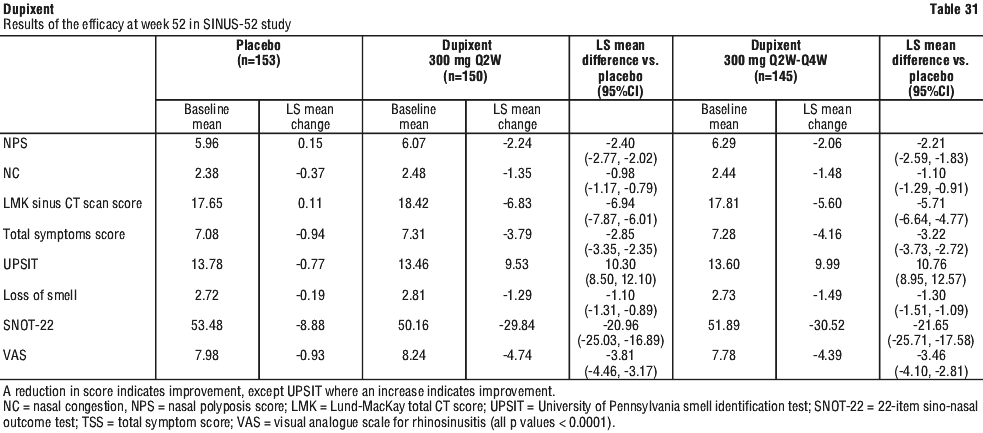 Statistically significant and clinically meaningful efficacy was observed in SINUS-24 with regard to improvement in bilateral endoscopic NPS score at week 24. In the post-treatment period when patients were off dupilumab, the treatment effect diminished over time (see Figure 19).
Statistically significant and clinically meaningful efficacy was observed in SINUS-24 with regard to improvement in bilateral endoscopic NPS score at week 24. In the post-treatment period when patients were off dupilumab, the treatment effect diminished over time (see Figure 19). Statistically significant and clinically meaningful results were also seen in SINUS-52 at both week 24 and week 52 with a progressive improvement over time (see Figure 20).
Statistically significant and clinically meaningful results were also seen in SINUS-52 at both week 24 and week 52 with a progressive improvement over time (see Figure 20).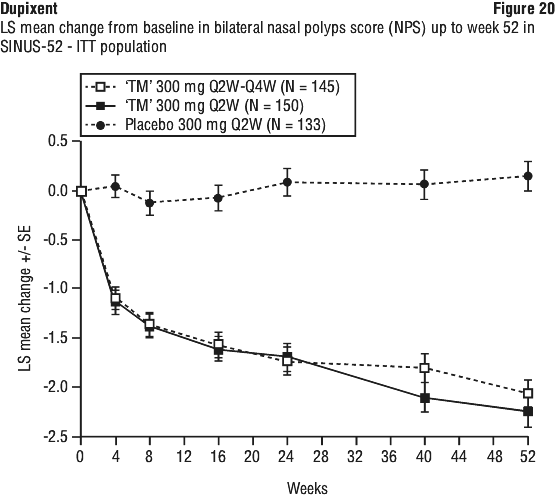 A significant decrease in LMK sinus CT scan score was also observed in SINUS-52 study at week 24 with further improvement at week 52 (see Figure 21). Similar results were seen in SINUS-24 study at week 24.
A significant decrease in LMK sinus CT scan score was also observed in SINUS-52 study at week 24 with further improvement at week 52 (see Figure 21). Similar results were seen in SINUS-24 study at week 24. In both studies, significant improvements in NC and daily loss of smell severity were observed as early as the first assessment at Week 4. The LS mean difference for NC at Week 4 in the Dupixent group versus placebo was 0.41 (95% CI: 0.52, 0.30) in SINUS-24 and -0.37 (95% CI: -0.46, -0.27) in SINUS-52. The LS mean difference for loss of smell at Week 4 in the Dupixent group versus placebo was 0.34 (95% CI: -0.44, -0.25) in SINUS-24 and -0.31 (95% CI: -0.41, -0.22) in SINUS-52.
In both studies, significant improvements in NC and daily loss of smell severity were observed as early as the first assessment at Week 4. The LS mean difference for NC at Week 4 in the Dupixent group versus placebo was 0.41 (95% CI: 0.52, 0.30) in SINUS-24 and -0.37 (95% CI: -0.46, -0.27) in SINUS-52. The LS mean difference for loss of smell at Week 4 in the Dupixent group versus placebo was 0.34 (95% CI: -0.44, -0.25) in SINUS-24 and -0.31 (95% CI: -0.41, -0.22) in SINUS-52. In patients with co-morbid asthma, significant improvement in pre-bronchodilator FEV1 were observed at Week 24 in the pre-specified multiplicity-adjusted pool of the two studies irrespective of baseline blood eosinophils levels. The LS Mean change from baseline in FEV1 at Week 24 for Dupixent 300 mg Q2W was 0.14 vs -0.07 L for placebo, for a difference of 0.21 L (95% CI: 0.13, 0.29).
In patients with co-morbid asthma, significant improvement in pre-bronchodilator FEV1 were observed at Week 24 in the pre-specified multiplicity-adjusted pool of the two studies irrespective of baseline blood eosinophils levels. The LS Mean change from baseline in FEV1 at Week 24 for Dupixent 300 mg Q2W was 0.14 vs -0.07 L for placebo, for a difference of 0.21 L (95% CI: 0.13, 0.29). Improvements in ACQ-6 in patients with co-morbid asthma were observed in both studies. A response was defined as an improvement in score of 0.5 or more. In SINUS-24, at Week 24, the LS mean difference in the Dupixent group versus placebo was 0.76 (95% CI: 1.00 to 0.51).432. In SINUS-52, at Week 52, the LS mean difference in the Dupixent group versus placebo was 0.94 (95% CI: 1.19, 0.69).
Improvements in ACQ-6 in patients with co-morbid asthma were observed in both studies. A response was defined as an improvement in score of 0.5 or more. In SINUS-24, at Week 24, the LS mean difference in the Dupixent group versus placebo was 0.76 (95% CI: 1.00 to 0.51).432. In SINUS-52, at Week 52, the LS mean difference in the Dupixent group versus placebo was 0.94 (95% CI: 1.19, 0.69).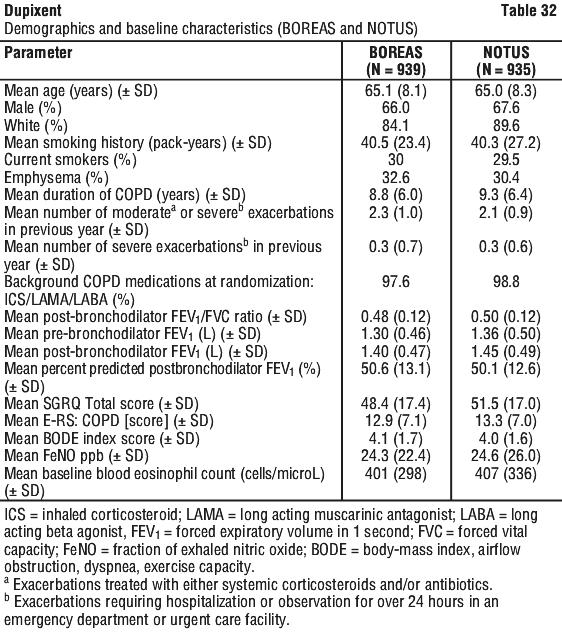
 In both trials, the cumulative mean number of moderate or severe exacerbations observed over 52 weeks was lower in subjects receiving Dupixent compared to placebo (see Figure 24 and Figure 25).
In both trials, the cumulative mean number of moderate or severe exacerbations observed over 52 weeks was lower in subjects receiving Dupixent compared to placebo (see Figure 24 and Figure 25).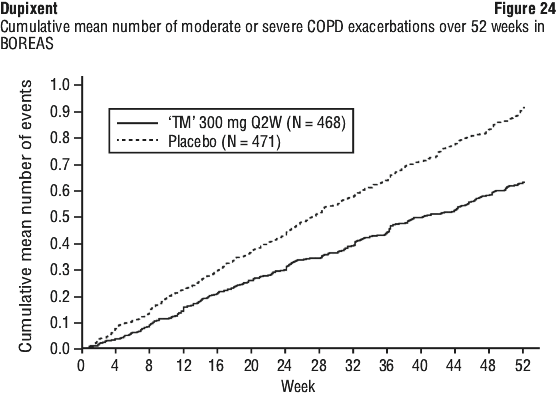
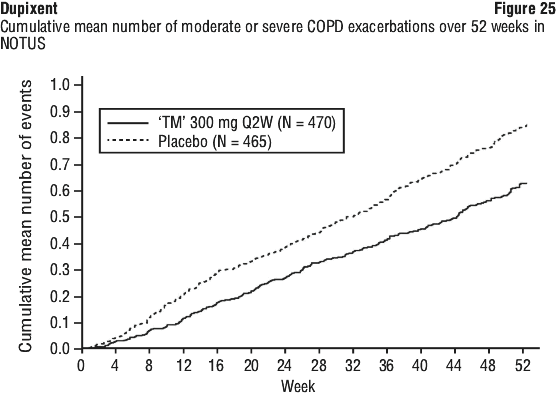 The time to first moderate or severe COPD exacerbation was longer for patients receiving Dupixent compared to placebo in BOREAS (HR: 0.80; 95% CI: 0.66, 0.98) and NOTUS (HR: 0.71.; 95% CI: 0.57, 0.889).
The time to first moderate or severe COPD exacerbation was longer for patients receiving Dupixent compared to placebo in BOREAS (HR: 0.80; 95% CI: 0.66, 0.98) and NOTUS (HR: 0.71.; 95% CI: 0.57, 0.889).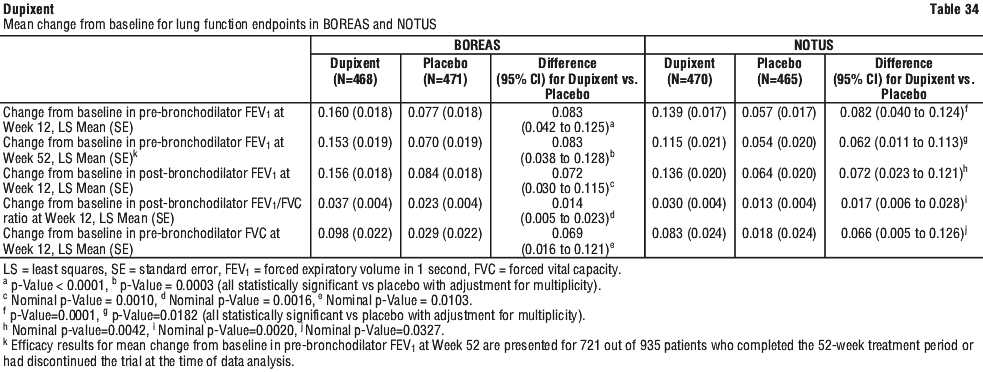
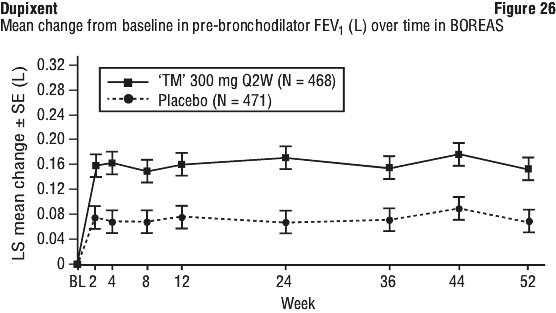
 In the subgroup analysis of patients with higher baseline FeNO (≥ 20 ppb) in BOREAS (N=383), treatment with Dupixent statistically significantly improved pre-bronchodilator FEV1 from baseline at Week 12 (LS mean change: 0.232 Dupixent vs 0.108 placebo; LS mean difference: 0.124 [95% CI: 0.045, 0.203]; p=0.002) and Week 52 (LS mean change: 0.247 Dupixent vs 0.120 placebo; LS mean difference: 0.127 [95% CI: 0.042, 0.212]; p=0.003) compared to placebo. In NOTUS, statistically significant improvement from baseline was observed in the subgroup of patients with a higher baseline FeNO (≥ 20 ppb) treated with Dupixent compared to placebo at Week 12 (N=355; LS mean change: 0.221 Dupixent vs 0.081 placebo; LS mean difference: 0.141 [95% CI: 0.058, 0.223]; p=0.001). Treatment with Dupixent improved pre-bronchodilator FEV1 at Week 52 in the subgroup of patients with higher baseline FeNO (≥ 20 ppb) compared to placebo in NOTUS (N=264; LS mean change: 0.176 Dupixent vs 0.095 placebo; LS mean difference: 0.081[95% CI: -0.019, 0.181]) but did not meet statistical significance.
In the subgroup analysis of patients with higher baseline FeNO (≥ 20 ppb) in BOREAS (N=383), treatment with Dupixent statistically significantly improved pre-bronchodilator FEV1 from baseline at Week 12 (LS mean change: 0.232 Dupixent vs 0.108 placebo; LS mean difference: 0.124 [95% CI: 0.045, 0.203]; p=0.002) and Week 52 (LS mean change: 0.247 Dupixent vs 0.120 placebo; LS mean difference: 0.127 [95% CI: 0.042, 0.212]; p=0.003) compared to placebo. In NOTUS, statistically significant improvement from baseline was observed in the subgroup of patients with a higher baseline FeNO (≥ 20 ppb) treated with Dupixent compared to placebo at Week 12 (N=355; LS mean change: 0.221 Dupixent vs 0.081 placebo; LS mean difference: 0.141 [95% CI: 0.058, 0.223]; p=0.001). Treatment with Dupixent improved pre-bronchodilator FEV1 at Week 52 in the subgroup of patients with higher baseline FeNO (≥ 20 ppb) compared to placebo in NOTUS (N=264; LS mean change: 0.176 Dupixent vs 0.095 placebo; LS mean difference: 0.081[95% CI: -0.019, 0.181]) but did not meet statistical significance.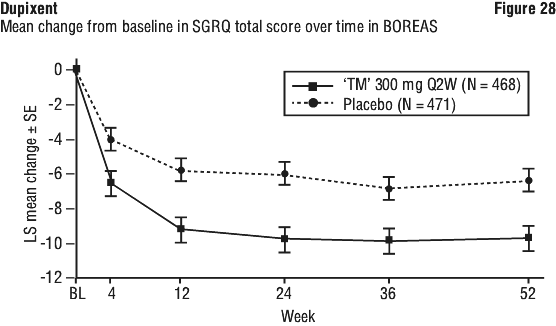
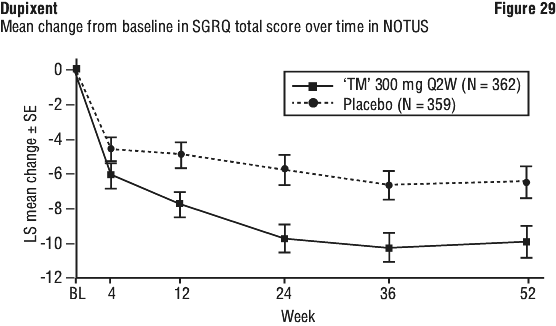 In BOREAS, Dupixent significantly improved overall respiratory symptoms compared to placebo as measured by LS mean change from baseline in the E-RS:COPD total score at Week 52 (LS mean change: -2.69 Dupixent vs -1.56 placebo; LS mean difference: -1.14 [95% CI: -1.82, -0.45]; p=0.001). Greater improvements in overall respiratory symptoms in patients treated with Dupixent compared to placebo as measured by average weekly change from baseline in the E-RS:COPD total score were observed as early as Week 1 and were maintained through Week 52 (see Figure 30). Consistent improvements were observed across all individual E-RS: COPD domains (cough and sputum, breathlessness, and chest-related symptoms).
In BOREAS, Dupixent significantly improved overall respiratory symptoms compared to placebo as measured by LS mean change from baseline in the E-RS:COPD total score at Week 52 (LS mean change: -2.69 Dupixent vs -1.56 placebo; LS mean difference: -1.14 [95% CI: -1.82, -0.45]; p=0.001). Greater improvements in overall respiratory symptoms in patients treated with Dupixent compared to placebo as measured by average weekly change from baseline in the E-RS:COPD total score were observed as early as Week 1 and were maintained through Week 52 (see Figure 30). Consistent improvements were observed across all individual E-RS: COPD domains (cough and sputum, breathlessness, and chest-related symptoms).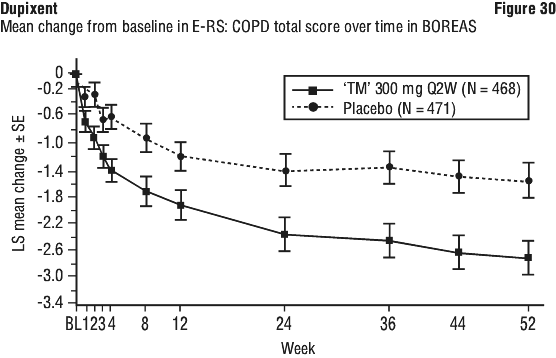
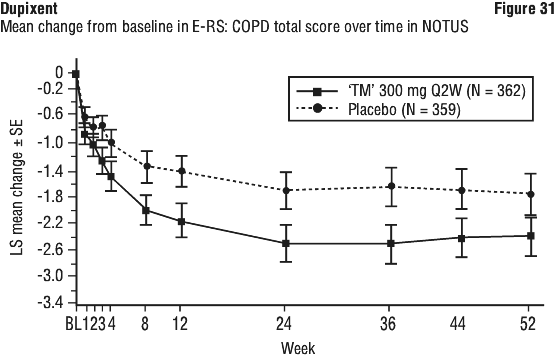
 Dupilumab is a covalent heterotetramer consisting of two disulfide-linked human heavy chains, each covalently linked through a disulfide bond to a human kappa light chain. There is a single N-linked glycosylation site in each heavy chain, located within the CH2 domain of the Fc constant region of the molecule. The dupilumab heavy chain has an immunoglobulin (Ig) G4P isotype constant region. IgG4P is an IgG4 constant region with a single amino acid substitution in the hinge region that recreates the IgG1 hinge sequence in order to stabilise IgG4 dimer formation. The variable domains of the heavy and light chains combine to form the IL-4Rα binding site within the antibody. Dupilumab has a molecular weight of approximately 147 kDa.
Dupilumab is a covalent heterotetramer consisting of two disulfide-linked human heavy chains, each covalently linked through a disulfide bond to a human kappa light chain. There is a single N-linked glycosylation site in each heavy chain, located within the CH2 domain of the Fc constant region of the molecule. The dupilumab heavy chain has an immunoglobulin (Ig) G4P isotype constant region. IgG4P is an IgG4 constant region with a single amino acid substitution in the hinge region that recreates the IgG1 hinge sequence in order to stabilise IgG4 dimer formation. The variable domains of the heavy and light chains combine to form the IL-4Rα binding site within the antibody. Dupilumab has a molecular weight of approximately 147 kDa.